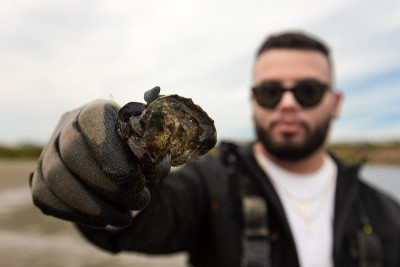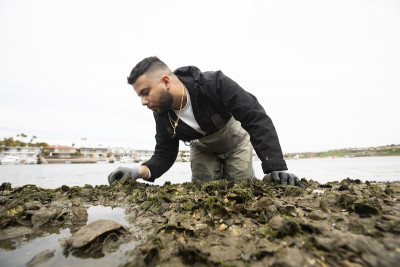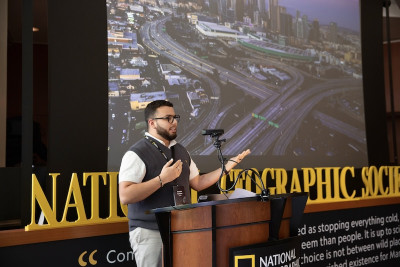When Brandon Quintana was little, he liked to spook himself by pretending that his inflatable pool in the backyard was an ocean full of sharks. “Looking back, it’s funny because I would think that ‘Jaws’ was in there in one foot of water,” says Quintana, now a California Sea Grant State Fellow with the California Coastal Commission. Growing up in Lynwood, a predominantly Hispanic city near Los Angeles, he didn’t experience much nature. “We didn't have the resources,” he says. The first time he went camping was during college, and Quintana had to ask for help figuring out how to pitch his tent.
But Quintana watched a lot of National Geographic nature documentaries as a kid and always enjoyed science. When, after high school, he attended Long Beach City College and landed in an ecology class, he quickly knew this was something about which he could become passionate. However, for Brandon researching how organisms relate to one another and their environment needs to include an added element: people. Particularly low-income and vulnerable communities.

Thinking about Fair Housing
“I feel there’s more overlap than we think between conservation and social equity,” says Quintana. After majoring in environmental studies at the University of California, Santa Barbara, then obtaining a master’s degree in biological studies from California State University, Fullerton, he picked the California Coastal Commission for his fellowship since it allows him to work on issues such as affordable housing. At the Commission, he now leads a project to integrate fair housing principles into coastal development planning by engaging the public to understand fair housing needs in the coastal zone and partnering with fair housing groups, environmental justice organizations, local governments and the California Department of Housing and Community Development.
For example, when converting former commercial sites to housing as has been suggested in some areas, “we need to take a step back and think about how we can protect not only the coastal resources but also the communities that will potentially live there,” says Quintana. “How far will the housing be from contaminants, for example?”
Breaking barriers
Quintana, who developed asthma as a kid, making him sensitive to air pollution, hopes to bring his lived experience to such issues. In college, he often felt “like a unicorn.” Being Latino and identifying as queer, Quintana encountered few others who were like him — or faced the same challenges. When he needed an Open Water Diver Certification for marine biology, for example, he didn’t know anybody who might lend him a pair of fins. And having to first get medical clearance from a lung specialist because of his asthma added to the unexpected expenses that often left Quintana scrambling.

During his master’s project — Quintana studied how oysters contribute to living shorelines that can increase biodiversity and protect coasts against sea level rise — he spent so many hours hunting for scholarships on the internet that his advisor was getting worried he might not have enough focus left for his actual research. “I said, ‘You don’t understand, I need these scholarships to keep doing the research,’” says Quintana, who still sometimes gets up at 4:30 a.m. to find time to go to the gym. Eventually, he secured another California Sea Grant Fellowship, this one for graduate research, which eased the financial strain.
Honoring a father’s legacy
Quintana has taken his expertise in living shorelines to his current State Fellowship — a program meant to let graduates experience how policies that affect marine resources are created and applied. At the California Coastal Commission, he is helping to develop guidance about integrating environmental justice initiatives into nature-based adaptation strategies, such as living shorelines, in essence “making us think about environmental justice and sea level rise at the same time.”
One of Quintana’s great inspirations has been his father, who died during Quintana’s college years. “He was very much — the big word would be ‘empathetic’ towards people, with a ‘you give the person the shirt off your back’ kind of energy,” he says.
Since his death, Quintana has tried to carry that spirit into his own life and work. “How can I center whatever I do on the person instead of the issue?” he frequently asks himself. He hopes to find a career that will allow him to fight climate change and social inequity simultaneously, maybe in a government position. “Blazing a path can be isolating, but it’s important to try to stay on it,” he says.

He hopes to inspire other young people. His frantic search for funding during his master’s project not only led him to a California Sea Grant Fellowship but also earned him a National Geographic Society Explorer Grant and Quintana was invited to talk about his work on the National Geographic's Explorer Classroom program. It was the culmination of a lifelong dream for Quintana — and something that might just end up exciting another young kid with an inflatable pool in the backyard.
About California Sea Grant
NOAA’s California Sea Grant College Program funds marine research, education and outreach throughout California. Headquartered at Scripps Institution of Oceanography at the University of California San Diego, California Sea Grant is one of 34 Sea Grant programs in the National Oceanic and Atmospheric Administration (NOAA), U.S. Department of Commerce.